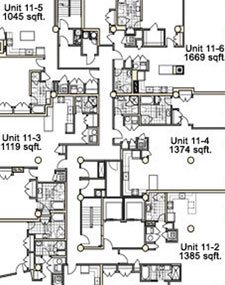
In Robert J. Bruss’ column on Inman News Where’s my missing 28 square feet? [Subscr]
>DEAR BOB: In August 2004, I purchased a junior one-bedroom condo, advertised as “approximately 551 square feet.” A week ago, I receive a list of recent sales in my building from the realty agent who sold my unit. It listed the condo like mine three floors above me, which sold at 523 square feet. That is 28 square feet smaller than I was lead to believe. If my math is correct, based on my purchase price I overpaid by $11,180 in square-foot value. Is “approximately” a common wording realty agents use to inflate the square footage and price? Should buyers be responsible for verifying this? The appraisal didn’t evaluate size. What advice do you have on recouping the misrepresented square footage and associated value? –Daniel R.
>DEAR DANIEL: Have you measured the square footage of your unit? Maybe the upstairs unit is different. Unless you can prove you paid on the basis of the advertised square footage, such as $200 per square foot, you would have a very weak case to prove misrepresentation.
>Most real estate listing information includes “weasel word” disclaimers such as “Information deemed reliable but not guaranteed.” You said your condo was advertised as “approximately” 551 square feet, indicating there was no specific representation.
Here are some thoughts:
* Who says the other unit size was correct? (My cynical side says it was).
* Most condo markets likely don’t show this type of precision.
* Offering plan methodologies for square footage measurements might vary building by building unless there are specific local government restrictions.
* An appraiser is not an architect. In condominiums, the appraiser will measure but test against the recorded measurement in public record or approved by the government authority that oversees the offering. In New York, its the attorney general. How could the appraiser not look at square footage?
* Some developers (in New York) have been including common areas in the interior calculations. While legal if disclosed, it strikes me as unethical.
* Shouldn’t the figure in public record always be used as the official number? I am surprised how often this number isn’t used.
* Why would the broker use a smaller square footage later if they were systematically exagerating as the complainer infers?
I don’t see how this buyer can do anything if all those disclaimers were used. I would bet that any two architects, any two brokers, any two appraisers who measured this unit would not come up with the exact same result.
3 Comments
Comments are closed.


As a broker when dealing with condos i use the square footage given in the offering plan and then say approximately. Reasoning being the offering plan to me is the official number and as you said everyone else who comes in to measure will get a different number. When buyers quibble my response is that all square footage is not the same or more clearly 1000 sf in one property will seem larger than 1000 sf in another. It comes down to usable space, how the space presents etc and then, what are you buying square footage or a home?
Whenever I appraise a condo, I always measure. Most times the official measurement is very close. I presume this is because the architect has to certify the plans.
N.Y. Real Property Law § 339-p
Nonetheless, I generally use the official measurement when doing the sales comparison approach. Why? Because that is what the typical buyer will consider. But I always include both measurements and explain to the bank the reason for the discrepancy (e.g., they included exterior walls, different method).
• When making such a large purchase, check the square footage yourself. Surprisingly most buyers probably skip this.
• Understand that measurements within 5% are fairly close. If 10 professionals measure, you will get 10 different measurements. But they will all be close to each other.
Nice analyis. I used to do “onsite” sales and have been through this before. I’ve yet to see a brochure floor plan match the condo docs, or what the architect has. Somehow the numbers are always different. You might as well measure it yourself and be done with it. It’s a scam, I tellya!